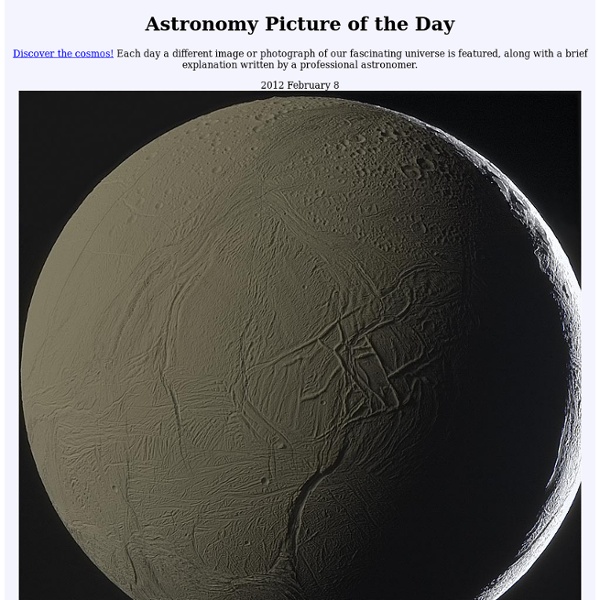



2012 January 24 - January Aurora Over Norway Discover the cosmos! Each day a different image or photograph of our fascinating universe is featured, along with a brief explanation written by a professional astronomer. 2012 January 24 Explanation: What's that in the sky? Astronomy Picture of the Day Discover the cosmos! Each day a different image or photograph of our fascinating universe is featured, along with a brief explanation written by a professional astronomer. 2016 April 15 Mercury and Crescent Moon Set Image Credit & Copyright: Miguel Claro (TWAN, Dark Sky Alqueva) Explanation: Innermost planet Mercury and a thin crescent Moon are never found far from the Sun in planet Earth's skies. Taken near dusk on April 8, this colorful evening skyscape shows them both setting toward the western horizon just after the Sun. Tomorrow's picture: Heliopause Electrostatic Rapid Transit System Authors & editors: Robert Nemiroff (MTU) & Jerry Bonnell (UMCP)NASA Official: Phillip Newman Specific rights apply.NASA Web Privacy Policy and Important NoticesA service of:ASD at NASA / GSFC& Michigan Tech.
PhotoShop CS6 官方简体中文正式版原版+破解补丁下载 | PlayNext 万众期待的 Adobe PhotoShop CS6 Extended 简体中文正式版终于推出了!!PS CS6 曾被业界认为是Adobe产品史上最大的一次升级!从界面设计、窗口布局功能体验上看 Photoshop CS6 确实改变了不少!外在上,PS的图标从原来的3D样式转变成了如今比较流行的平面简单风格,而用户界面的主色调也重新设计成了深色;内在方面最明显的便是 PS CS6 为摄影师提供了基本的视频编辑功能,同时在指针、图层、滤镜等各方面也发生了不同程度的变化。 PS CS6 中整合了 Adobe 专有的 Mercury图像引擎,通过显卡核心GPU提供了强悍的图片编辑能力。Content-Aware Patch帮助用户更加轻松方便的选取区域,方便用户抠图等操作。 安装与破解使用方法: 安装前请最好先卸载 PhotoShop CS5,之前安装的第三方滤镜直接复制到CS6新的滤镜目录就可以直接使用。 1、下载 PhotoShop CS6 官方原版安装包,先以试用的模式安装完成软件。 相关文件下载地址: PS:必须使用迅雷才能正常下载,解压密码为:www.playnext.cn 下载 PhotoShop CS6 简体中文官方正式版 | 下载CS6破解补丁 | 来自PlayNext | 更多Adobe产品
2012 March 14 - Angry Sun Erupting Discover the cosmos! Each day a different image or photograph of our fascinating universe is featured, along with a brief explanation written by a professional astronomer. 2012 March 14 Explanation: It's one of the baddest sunspot regions in years. 2012 September 17 - A Solar Filament Erupts Discover the cosmos! Each day a different image or photograph of our fascinating universe is featured, along with a brief explanation written by a professional astronomer. 2012 September 17 Explanation: What's happened to our Sun? Nothing very unusual -- it just threw a filament. At the end of last month, a long standing solar filament suddenly erupted into space producing an energetic Coronal Mass Ejection (CME).
百度百科 2012 January 22 - Saturn's Hexagon Comes to Light Discover the cosmos! Each day a different image or photograph of our fascinating universe is featured, along with a brief explanation written by a professional astronomer. 2012 January 22 Saturn's Hexagon Comes to Light Image Credit: Cassini Imaging Team, SSI, JPL, ESA, NASA Explanation: Believe it or not, this is the North Pole of Saturn. It is unclear how an unusual hexagonal cloud system that surrounds Saturn's north pole was created, keeps its shape, or how long it will last. Tomorrow's picture: ground or sky? Authors & editors: Robert Nemiroff (MTU) & Jerry Bonnell (UMCP)NASA Official: Phillip Newman Specific rights apply.NASA Web Privacy Policy and Important NoticesA service of:ASD at NASA / GSFC& Michigan Tech.
Astronomy Picture of the Day 百度知道 - 全球最大中文互动问答平台 2011 December 26 - A Raging Storm System on Saturn Discover the cosmos! Each day a different image or photograph of our fascinating universe is featured, along with a brief explanation written by a professional astronomer. 2011 December 26 A Raging Storm System on Saturn Image Credit: Cassini Imaging Team, SSI, JPL, ESA, NASA Explanation: It is one of the largest and longest lived storms ever recorded in our Solar System. Fun Quiz: Celestial or Cellular -- can you tell the difference? Authors & editors: Robert Nemiroff (MTU) & Jerry Bonnell (UMCP)NASA Official: Phillip Newman Specific rights apply.NASA Web Privacy Policy and Important NoticesA service of:ASD at NASA / GSFC& Michigan Tech.